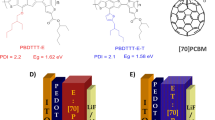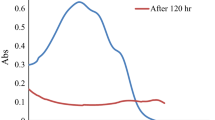Abstract
Degradation (D) of organic light-emitting diodes (OLEDs) based on new different-ligand complexes of terbium salicylate (Tb(Sal)3(TPPO)2) and 2-phenoxybenzoate (Tb(pobz)3(TPPO)2) with triphenyl phosphinoxide (TPPO) was studied. Initial reversible D is associated with charge carrier trap filling. A temperature increase, applied stress relief, and short-term irradiation with UV light lead to trapped charge carrier release and electroluminescence (EL) intensity recovery. During strong heating, irreversible D is observed after the recovery; this D requires in addition an electric field (EF). Intense UV light causes D without EF. The use of ac bias voltage eliminates reversible D, and sealing retards irreversible long-term D.
Similar content being viewed by others
References
P. E. Burrows et al., Appl. Phys. Lett. 65, 2922 (1994).
V. Cimrová et al., Synth. Met. 67, 103 (1994).
H. Aziz et al., Science 283, 5409 (1999).
Z. D. Popovic and H. Aziz, IEEE J. Sel. Top. Quantum Electron. 8, 362 (2002).
H. Aziz and G. Hu, Synth. Met. 80, 7 (1996).
S. Eliseeva, Synth. Met. 141, 225 (2004).
L. Lepnev et al., Synth. Met. 156, 624 (2006).
O. V. Kotova et al., J. Alloys and Comp. (2007) (in press).
P. E. Burrows and S. R. Forrest, Appl. Phys. Lett. 64, 2285 (1994).
P. E. Burrows et al., J. Appl. Phys. 79, 7991 (1996).
D. C. Zou, M. Yahiro, and T. Tsutsui, in Proc. Int. Conf. Electroluminescence of Molecular Materials & Related Phenomena, Kitakyushu, 1997 (Fukuoka University, Fukuoka, 1997), p. 71.
D. Zou, Appl. Phys. Lett. 72, 2484 (1998).
D. C. Zou, M. Yahiro, and T. Tsutsui, Synth.Met. 91, 191 (1997).
D. Zou, M. Yahiro, and T. Tsutsui, Jpn. J. Appl. Phys. 37, L1406 (1998).
S. A. Van Slyke, C. H. Chen, and C.W. Tang, Appl. Phys. Lett. 69, 2160 (1996).
Author information
Authors and Affiliations
Additional information
Original Russian Text © L.S. Lepnev, A.A. Vashchenko, A.G. Vitukhnovskii, S.V. Eliseeva, O.V. Kotova, N.P. Kuzmina, 2007, published in Kratkie Soobshcheniya po Fizike, 2007, Vol. 34, No. 4, pp. 12–20.
About this article
Cite this article
Lepnev, L.S., Vashchenko, A.A., Vitukhnovskii, A.G. et al. Degradation of organic light-emitting diodes based on different-ligand complexes of terbium (III) salicylate and 2-phenoxybenzoate. Bull. Lebedev Phys. Inst. 34, 102–106 (2007). https://doi.org/10.3103/S1068335607040021
Received:
Issue Date:
DOI: https://doi.org/10.3103/S1068335607040021




